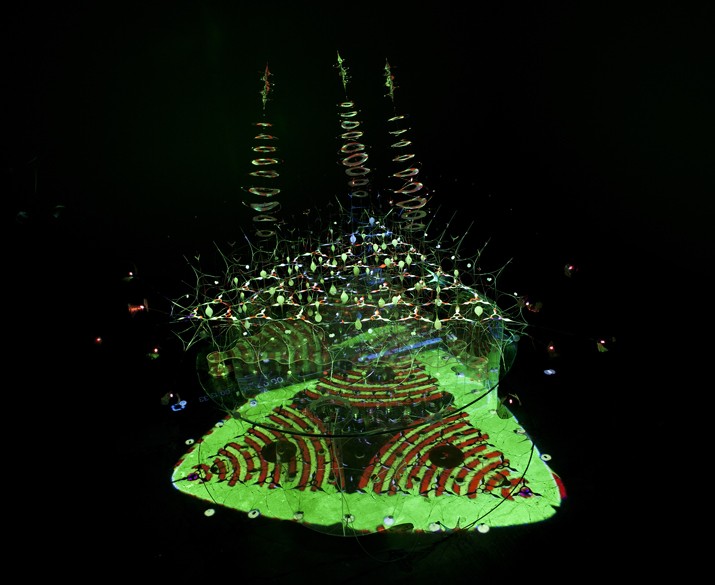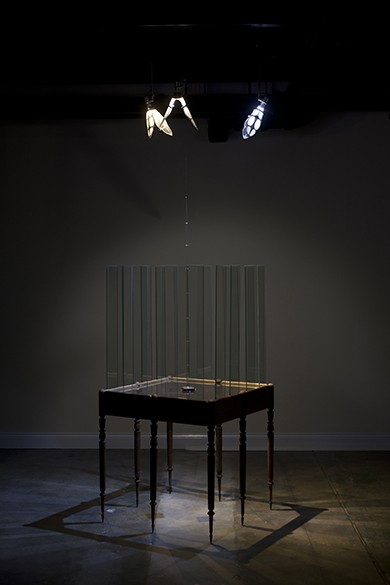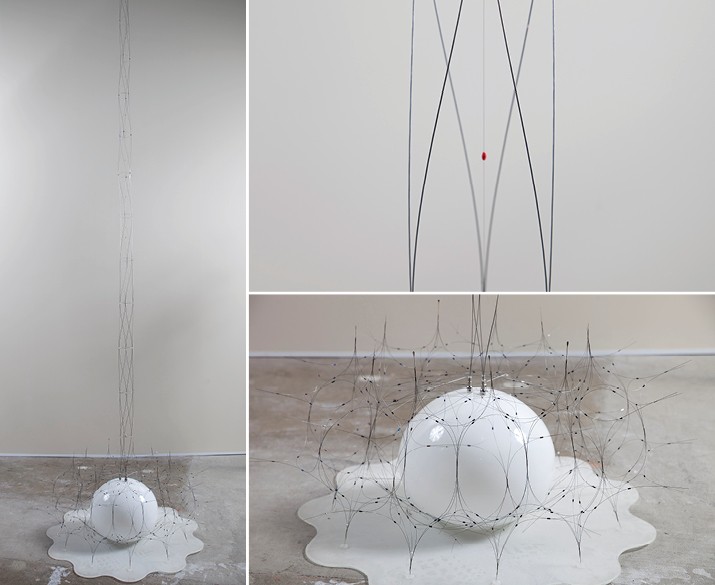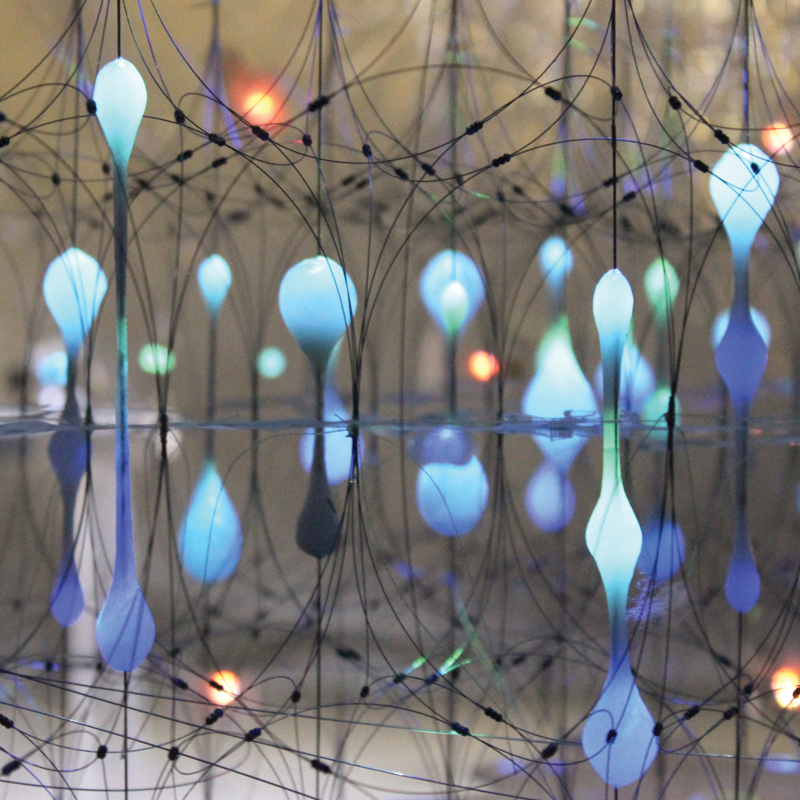Bill Smith's art emerges from an analysis of our increasingly technologically advanced society and our shrinking natural world.
On View: March 7 - August 25, 2013
With a background in sculpture, microbiology, chemistry, and mechanics, Smith creates art inspired by disciplines outside of the humanities where the aesthetic beauty of Smith’s creations is a byproduct of his process. By understanding the way nature works on a microcosmic level, he mimics nature’s growth characteristics and inherent beauty. Smith sees the celebration of the human condition as being overrepresented in contemporary art and believes that, by focusing on the universe at large, art can attain a broader significance.
Beyond the Humanities explores how rules guide the creation of our world’s structure and behavior. Rules are basic to existence and are the foundation from which complexity grows and beauty is manifested. Through this collection of sculptures and videos, Smith challenges the viewers to ponder their future and experience nature’s complexity by looking at its patterns and interactions.
Like Smith’s work, chess is defined by rules, patterns, and interactions. The rules of a game are analogous to the laws of nature. Both games and nature are systems made up of rules within which players, planets, species or individuals must function. The more efficient the players are at “using” the rules, the more successful they will become.
The rules of chess were elegantly constructed to create an environment in which elements struggle and interact. This microcosm has a special kinship with the dynamics seen in social animal behavior—especially those of humans, hornets, and wolves. Animals try to gain supremacy over sister groups of the same species—hive parasitizes hive; pack attacks pack; humans go to war. Chess can be seen as a game inspired by the reality of intra-species conflict—the opposing sides, identical except for color, battle to dominate the shared territory of the game board and ultimately destroy the enemy.
In order to highlight the intersection of art, chess, and nature, Smith uses art to show the underlying similarities of all things. His videos and constructions give a holistic view of the world by presenting the ubiquitous patterns and interactions common to music, games, technology, animals, molecules, and the galaxy.
About Bill Smith
Bill Smith lives and works in southern Illinois and is represented by P.P.O.W Gallery, New York. He received a certificate in mechanics from Ranken Technical Institute, a Bachelor of Science degree in Microbiology and Chemistry from Southern Illinois University, and a Master of Fine Arts degree in Sculpture from the University of Illinois, Champaign-Urbana.
Smith’s work has been featured in several solo exhibitions including: P.P.O.W Gallery, New York (2012, 2009, 2007); Saint Louis Art Museum (2008); Gallery 210, Saint Louis (2007); White Flag Projects, Saint Louis (2006); and Chicago Cultural Center (2005). His work has been shown in numerous group exhibitions throughout North Amrica including: Richard Heller Gallery, Santa Monica (2012); SEVEN, Miami (2011); New Museum, New York (2011); Fabric Workshop and Museum, Philadelphia (2010, 2009); PULSE, New York (2010, 2007); PULSE, Miami (2010, 2007); Biennale de Montréal (2007); Parisian Laundry, Montreal (2006); Toronto Alternative Art Fair International (2005); Stray Show, Chicago (2005); Gallery 312, Chicago (2004); and Illinois State Museum, Springfield (2004). Bill has been awarded grants from the Nimoy Foundation (2008), National Endowment for the Arts (2009), and the Warhol Foundation (2010).
The energy used in this exhibition has been greatly reduced due to the use of LED lighting. The gallery contains fifteen 4 watt bulbs which equals a total of 60 watts of light energy used per hour.
Works Featured in the Exhibition

Bill Smith
spherodendron, 2010
Multimedia
84 x 84 x 84 inches
Courtesy of the artist
A spherodendron is a non-linear network that becomes more complex as it expands from its center. The network’s nodes, or branching events, punctuate the maze-like structure. With closer examination, the nodes can be seen to form concentric layers like the spherical shells that make up the earth or an atom’s orbital structure. Smith’s work models nature to create systems that help in the visualization of complex networks. Similar non-linear networks can be seen in the structure of the Internet, the brain and the shape of the early universe. Smith believes that understanding complex interactions is required for man to create a sustainable future.

Bill Smith
graphyne, 2012
Multimedia
36 x 36 x 36 inches
Courtesy of the artist
Though previously unaware of this specific molecule, graphyne, Smith did know of the nature and chemistry which allowed for it to exist. He uses animation and symbology to visualize the material.
Graphyne
This is a molecular model that uses symbolism and visualization to represent the strange reality of nature’s workings.
Imagine “seeing” this section of molecular lattice oscillate as it incorporates energy in quantum increments. I speculate many strangely beautiful electromagnetic phenomena emerge as macromolecular structures function.
This creation is based on what we know about the structure and electromagnetic behavior of a material called graphyne. Graphyne is made of carbon atoms; graphyne is a carbon allotrope bi-layer made up of hexagonal monomers arranged in a plane with uniform geometry. This particular molecular model represents 360 carbon atoms.
The graphyne molecular lattice has extraordinary properties, most notably it is vastly superior to the silicon used in current electronics. Graphyne is the nanotechnological equivalent to silicon based wafers. Graphyne exhibits quantum tunneling within nanorings perpendicular to the molecular plane. Monolithic graphyne transistor arrays may soon be a reality. Graphyne technology will lead to dramatic technological innovations (i.e. quantum computing) that may create a post biological society, a world where our biological existence melds with our nano-mechanical/electronic creations.
Cultivating mystery is a powerful tool for spurring innovation in art and science.
-Bill Smith

Bill Smith
structure, 2013
Multimedia
3 x 3 x 258 inches
Courtesy of the artist
This 20-foot tall tower weighing approximately two ounces is inspired by macromolecular structures. The resulting stack of interconnected modules becomes a flexible integrated polymer unit.
Structure sits on a load cell scale, which records the tower’s subtle movements, and projects them on the monitors nearby. The load cell scale’s sensor emits an electrical signal whose strength is relative to the pressure applied to it. A very similar tower sensor system exists in nature—mammals use hair tower/cell sensors to hear, fish use them as pressure sensors in the form of a lateral line system, and insects use them as pressure sensors in the form of an array. In nature, these adaptations allow species to sense changes in their environment.
Man is building mimics of this hair/cell sensor system through MEMS (micromechanical systems technology). These nanosensor arrays have a myriad of real-world applications, like detecting cancer and speeding the development of phamaceutical drugs. This is a model of a large tower or a “smart tower” that Smith hopes to build using carbon fiber that will respond to a range of environmental conditions.
This tower’s vertically-oriented geometry is based on the nanoarchitecture of macromolecules and is comprised of interconnected preloaded modules that form an integrated polymer unit. The component modules are twisted three-dimensional geometric structures based on the golden ratio. The structure of the tower is based upon the form of a damped sine wave. As the tower gains height, the wave amplitude decreases and the tower narrows, tapering to a point at its top.
The structure’s flexible lattice is integrated structurally like a crystal. This holistic architecture allows small changes in the position of the tower’s base to change its overall structural characteristics. For example, the tower can arc, changing height and also rigidity.
Two smaller versions of this tower are also presented as part of this exhibition:

Bill Smith
original tower maquette, 2013
Multimedia
1 x 1 x 48 inches
Courtesy of the artist

Bill Smith
second tower maquette, 2013
multimedia
24 x 24 x 129 inches
Courtesy of the artist

Bill Smith
catalytic actuator prototype, 2013
Multimedia
31 x variable x 54 inches
Courtesy of the artist
This structure is an early experiment in creating a process using the tension stored in a bent structure to help change its own shape. The benefit of this process is the reduction in the amount of energy needed for an actuator, a device that controls motion or a system, to perform a task. Inspired by chemistry and many analogous examples in nature, Smith is exploring means of decreasing uses of energy. For example, in many chemical reactions, a catalyst is introduced to reduce the amount of energy necessary for the process to occur.
Click here to view all videos pertaining to Bill Smith: Beyond the Humanities.
-

Special Project
May 4, 2013
Read More

Financial assistance has been provided by the Missouri Arts Council, a state agency.








